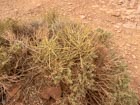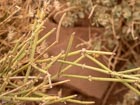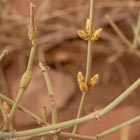Ephedra torreyana
S. Watson 1879
Common names
Mormon tea, Brigham tea, Mexican tea, jointfir, cañutillo, cañatilla, tepopote (Elmore and Janish 1976).
Taxonomic notes
Two varieties, the type and Ephedra torreyana S. Watson var. powelliorum T.Wendt.
"Ephedra torreyana is known to form hybrids with two other species of Ephedra as reported and described by Cutler (1939). The first of these is E. × intermixta Cutler, the hybrid between E. torreyana and E. trifurca. This hybrid occurs in a small area of southwestern New Mexico (near Engle, Sierra County) within the zone of sympatry of the two parental species; it may be fertile (mature seeds are formed). It is intermediate in most characters but can be identified by its combination of the spinelike terminal buds of E. trifurca and the scabrous, light yellow seeds of E. torreyana.
"The second hybrid is Ephedra × arenicola Cutler, the hybrid between E. torreyana and E. cutleri. This hybrid is known only from the type locality in extreme northeastern Arizona (near Dennehotso, Apache County) in an area of sympatry of the parental species. This hybrid is intermediate in most characters, but it can be distinguished by its combination of the setaceous leaves, viscid stems, and long-pedunculate seed cones of E. cutleri with the persistent, whorled leaves of E. torreyana" (Stevenson 1993).
Description
"Shrubs erect, 0.25-1 m. Bark gray, cracked and irregularly fissured. Branches alternate or whorled, rigid, angle of divergence about 45 . Twigs blue-green, becoming gray with age, glaucous, with numerous very fine longitudinal grooves; internodes 2-5 cm. Terminal buds conic, less than 4 mm. Leaves in whorls of 3, 2-5 mm, connate to 2/3 their length; bases becoming gray and shredded with age; apex acute. Pollen cones 1-4 at node, ovoid, 6-8 mm, sessile; bracts in 6-9 whorls of 3, cream to pale yellow, ovate, slightly clawed, 2-4 × 2-4 mm, membranous; bracteoles slightly exceeding bracts; sporangiophores 2-4 mm, exserted to 1/2 their length, with 5-8 sessile to short-stalked microsporangia. Seed cones 1-several at node, ovoid, 9-15 mm, sessile; bracts in 5 or 6 whorls of 3, obovate, 6-9 × 6-10 mm, papery, translucent with orange-yellow to greenish yellow center and base, base clawed, margins minutely dentate, undulate. Seeds 1-2(-3), ellipsoid, 7-10 × 1.5-3 mm, light brown to yellowish green, scabrous. ... Coning spring" (Stevenson 1993).
Stevenson (1993) provides this Key to the North American species of Ephedra. The Jepson eFlora key is also useful for distinguishing it from other Ephedra native in California. It's not always especially helpful. I find that E. torreyana is distinctive relative to other Ephedra in its range due leaves and cones in whorls of 3, and due to the irregular branching habit, with stems that are thick relative to the distance between nodes.
Distribution and Ecology
USA: Colorado, Utah, Nevada, Arizona, New Mexico & Texas; Mexico: Chihuahua. Found on dry rocky to sandy areas at 500-2000 m (Stevenson 1993).
Remarkable Specimens
No data as of 2023.03.03.
Ethnobotany
"From its dried stems, early pioneers brewed a hot drink, though the Navajo roasted the stems first, claiming that it improved the flavor" (Elmore and Janish 1976).
Observations
See the observations on iNaturalist, accessed 2021.12.31.
Remarks
The epithet honors pioneering American botanist John Torrey (1796-1873).
Citations
Cutler, H. C. 1939. Monograph of the North American species of the genus Ephedra. Annals of the Missouri Botanical Garden 26:373-427. Available: Biodiversity Heritage Library, accessed 2021.12.28.
Watson, Sereno. 1879. Contributions to American botany. II. Descriptions of some new species of North American plants. Proceedings of the American Academy of Arts and Sciences 14:288-303, p. 299. Available: Biodiversity Heritage Library, accessed 2021.12.29.
See also
Species profile at Plants of the World Online, accessed 2021.12.31.



